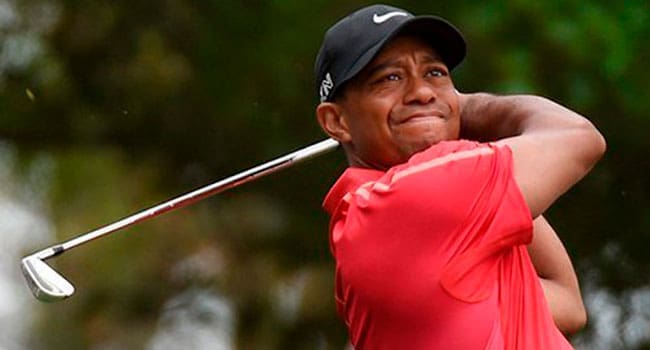 It will be eight years this U.S. Thanksgiving since the golf shot heard around the world. Hard to believe it’s been that long since Tiger Woods’ wife Elin practised her short game on the back of his car in response to his infidelity.
It will be eight years this U.S. Thanksgiving since the golf shot heard around the world. Hard to believe it’s been that long since Tiger Woods’ wife Elin practised her short game on the back of his car in response to his infidelity.
Things have only gotten tougher for Tiger since that ill-fated night. Injuries have sidelined him for long stretches since, resulting in spinal fusion. And he recently pleaded guilty to a DUI charge from earlier this year.
But golf fans still cling to the hope of a comeback from the man who brought the sport to its knees in the years after he turned pro in 1996.
So the news that Tiger is healthy enough to try another comeback was greeted with excitement by some and skepticism by others. Where it was once a given that he’d tie or break Jack Nicklaus’s record of 18 major tournament wins, most people would be happy to see him win one tournament – any tournament – in the future.
But there are those who discount his chances. Woods may be one of the biggest doubters. Even if he’s 100 per cent healthy, the 41-year old-admits he’s a work in progress.
“It’s a different feeling,” Woods said on basketball coach Geno Auriemma’s podcast. “I’m a little bit tighter. I don’t have the pain. I don’t know if I’m going to loosen up or if this is the way I’m always going to be.”
Woods is also the first to admit that the old Tiger has seen the the modern game leave him in its vapour trail. Where fans once “oohed and aahed” at his 300-yard drives, today’s sluggers such as Rory McIlroy and Dustin Johnson are tagging it 350 to 360 yards. Unless he can find a way to make up those difference, Woods will be left behind with all the other players who couldn’t stretch out their games.
Woods thinks he can still do that if his body doesn’t betray him. He told the podcast, “I’m back to hitting it my full numbers (yardages) and not really trying to do that. I didn’t realize how much I had dropped off because of the pain in my back, and from me going at it and hitting it normal just because I just lived it from day-to-day. And I really couldn’t tell the difference. But now I can tell the difference.”
While Woods thinks he can get out to those stratospheric distances, he’s not pleased that the game has reached the point where 440-yard par-fours are simply a driver and a flip wedge for some pros.
And he has a culprit.
As Woods told Lorne Rubenstein in their book The 1997 Masters: My Story, the sport has to do something about the golf ball. “It probably makes me sound like an old-timer saying things were better back in the day, but I don’t see how anybody could say it’s a good thing that the ball is going so far, and that it doesn’t curve as much because it doesn’t spin. Driving the ball accurately used to be more important than now, and I know that because I got myself in plenty of trouble by missing fairways.”
“If you put today’s players on the Augusta National course I played in 1999, with the equipment we use today, somebody would go very low … today’s players are probably 30 yards longer than I was. With so many hitting it so long, somebody would break 60.”
The desire for longer drives is also going to bankrupt golf, says Woods. He told Auriemma’s podcast “if the game keeps progressing the way it is with technology, I think the 8,000-yard golf course is not too far away. And that’s pretty scary, because we don’t have enough property to start designing these type of golf courses, and it just makes it so much more complicated.”
Legends Nicklaus, Tom Watson and Greg Norman agree.
So what’s standing in the way of this change? After all, every other competitive sport decides the characteristics of the ball used in competition.
What if players could decide how the basketball would bounce or the puck fly or the tennis ball respond on the racquet? It’s this attention to detail that caused New England Patriots quarterback Tom Brady’s demise in DeflateGate and prompted the alarm this summer over how many home runs were hit with the ball Major League Baseball had in play.
But golf? Players and manufacturers have worked in tandem to distort the traditional boundaries of the game.
“The manufacturers beat the USGA (United States Golf Association) and the R&A (Royal and Ancient Golf Club of St. Andrews),” Watson has said. “They made a golf ball that beat them. They hoodwinked them. Now it’s time to bring the golf ball back, I think, for everybody. The question is, do you bring it back for everybody?
“If you look at it, the longer hitters will be affected more by it than the shorter hitters, from the percentage standpoints of how far they hit it. That’s what you’ve got to do.”
The governing bodies have talked a good game about restraint but have given no hint that things will change. Some suggest the Masters – which could dictate terms of the golf ball – defy the onslaught by mandating everyone use a similar ball.
Because for Tiger and his fused back, a defused ball may be his only hope at winning another tournament – let alone major – in his 40s.
Troy Media columnist Bruce Dowbiggin career includes successful stints in television, radio and print. A two-time winner of the Gemini Award as Canada’s top television sports broadcaster, he is also the publisher of Not The Public Broadcaster.
The views, opinions and positions expressed by columnists and contributors are the author’s alone. They do not inherently or expressly reflect the views, opinions and/or positions of our publication.

